Case Study Analysis: Tesco Plc's Operational Management and Strategies
VerifiedAdded on 2023/01/05
|10
|2439
|94
Case Study
AI Summary
This case study examines the business operations of Tesco Plc, a multinational retailer. It provides an overview of the company's structure, history, and core values, emphasizing its commitment to customer satisfaction and responsible retailing. The study delves into Tesco's operational management decisions, including production, supply chain (specifically its evolution from direct store delivery to lean supply chain), logistics strategies (inbound and outbound), and location strategies. Furthermore, it analyzes Tesco's human resource strategies, such as recruitment, selection, and training and development programs. Finally, the report addresses Tesco's quality control processes, highlighting its approach to ensuring product quality and meeting customer requirements. The case study concludes that Tesco's success is attributed to its effective operational management, customer-centric approach, and commitment to delivering high-quality products at competitive prices.
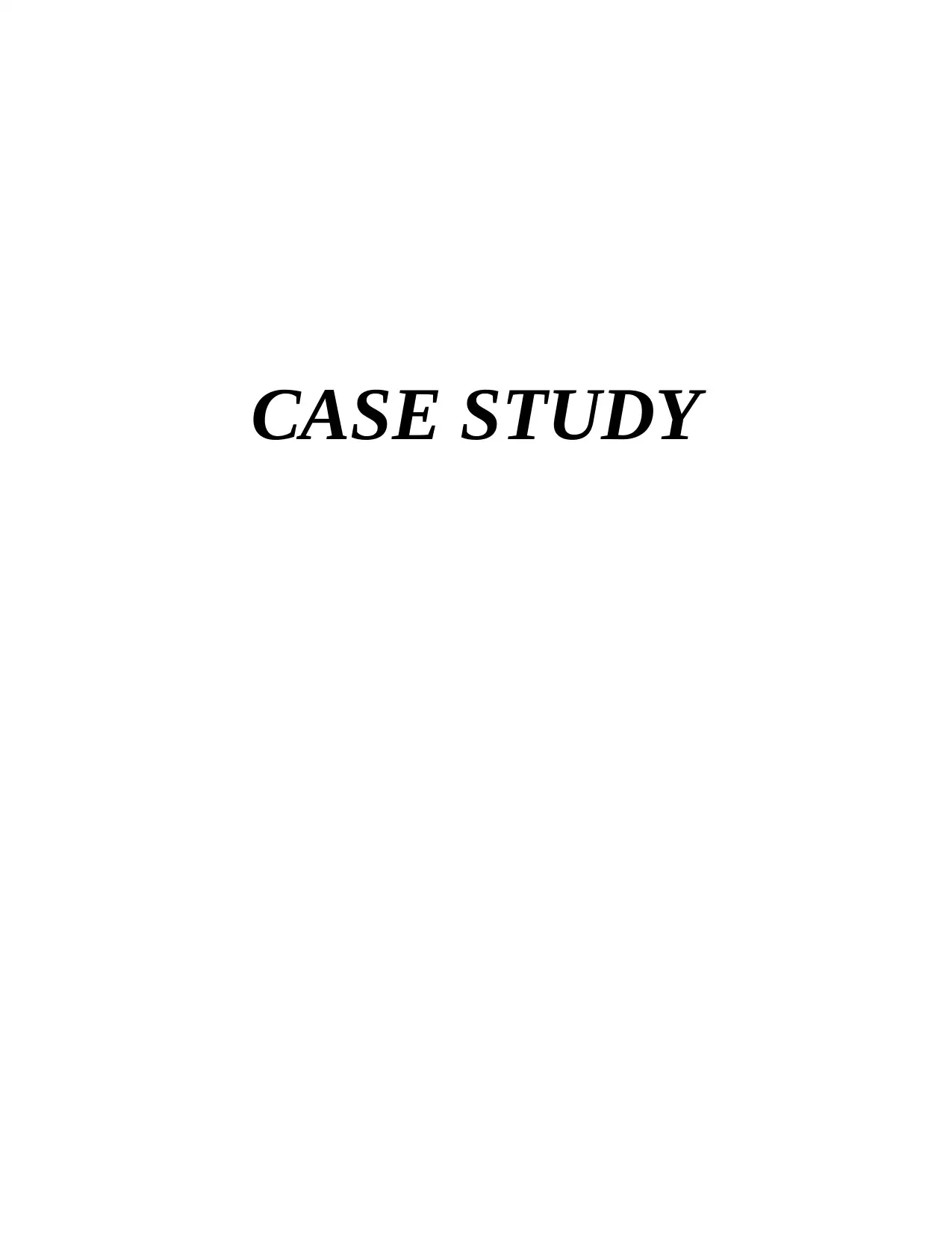
CASE STUDY
Paraphrase This Document
Need a fresh take? Get an instant paraphrase of this document with our AI Paraphraser
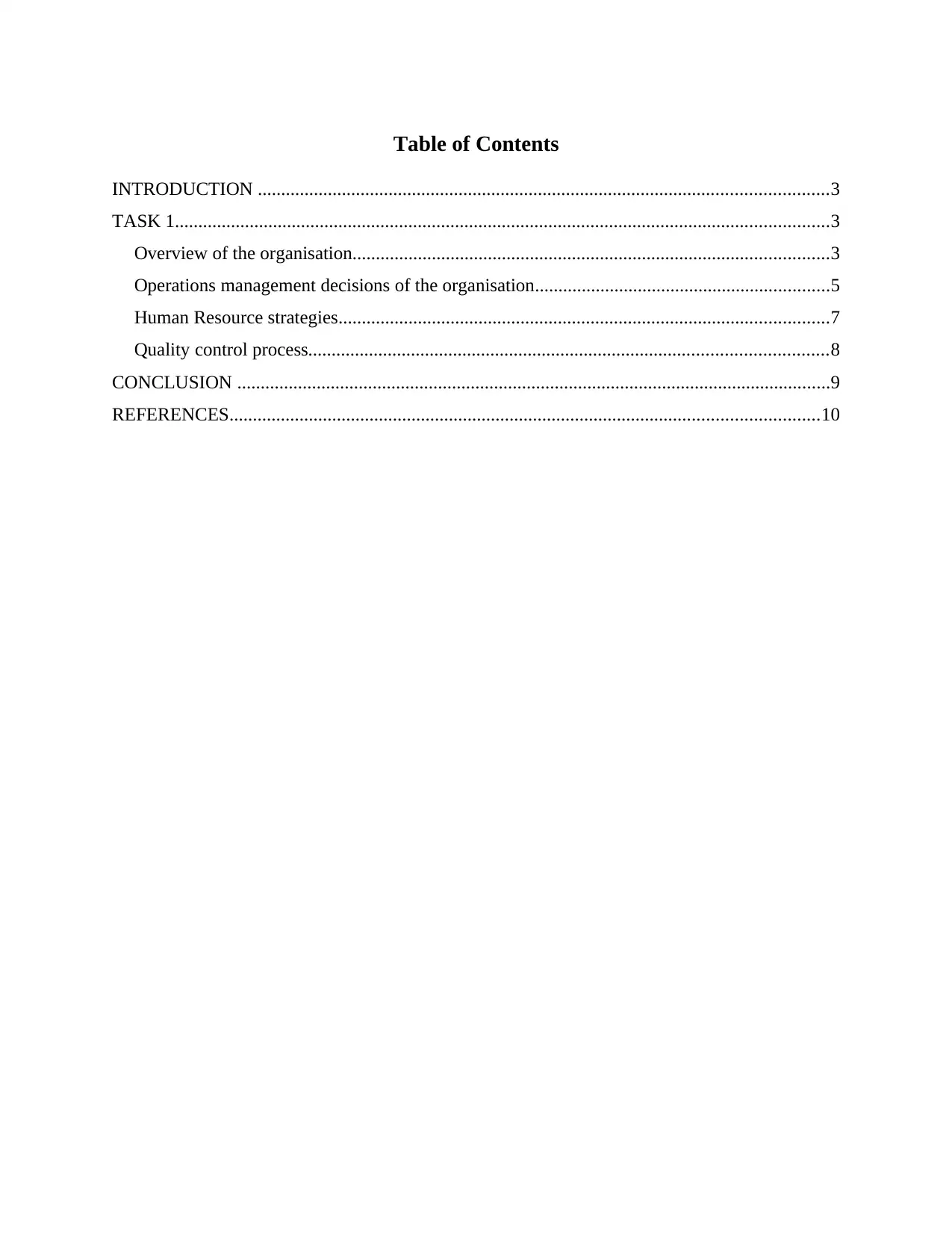
Table of Contents
INTRODUCTION ..........................................................................................................................3
TASK 1............................................................................................................................................3
Overview of the organisation......................................................................................................3
Operations management decisions of the organisation...............................................................5
Human Resource strategies.........................................................................................................7
Quality control process...............................................................................................................8
CONCLUSION ...............................................................................................................................9
REFERENCES..............................................................................................................................10
INTRODUCTION ..........................................................................................................................3
TASK 1............................................................................................................................................3
Overview of the organisation......................................................................................................3
Operations management decisions of the organisation...............................................................5
Human Resource strategies.........................................................................................................7
Quality control process...............................................................................................................8
CONCLUSION ...............................................................................................................................9
REFERENCES..............................................................................................................................10
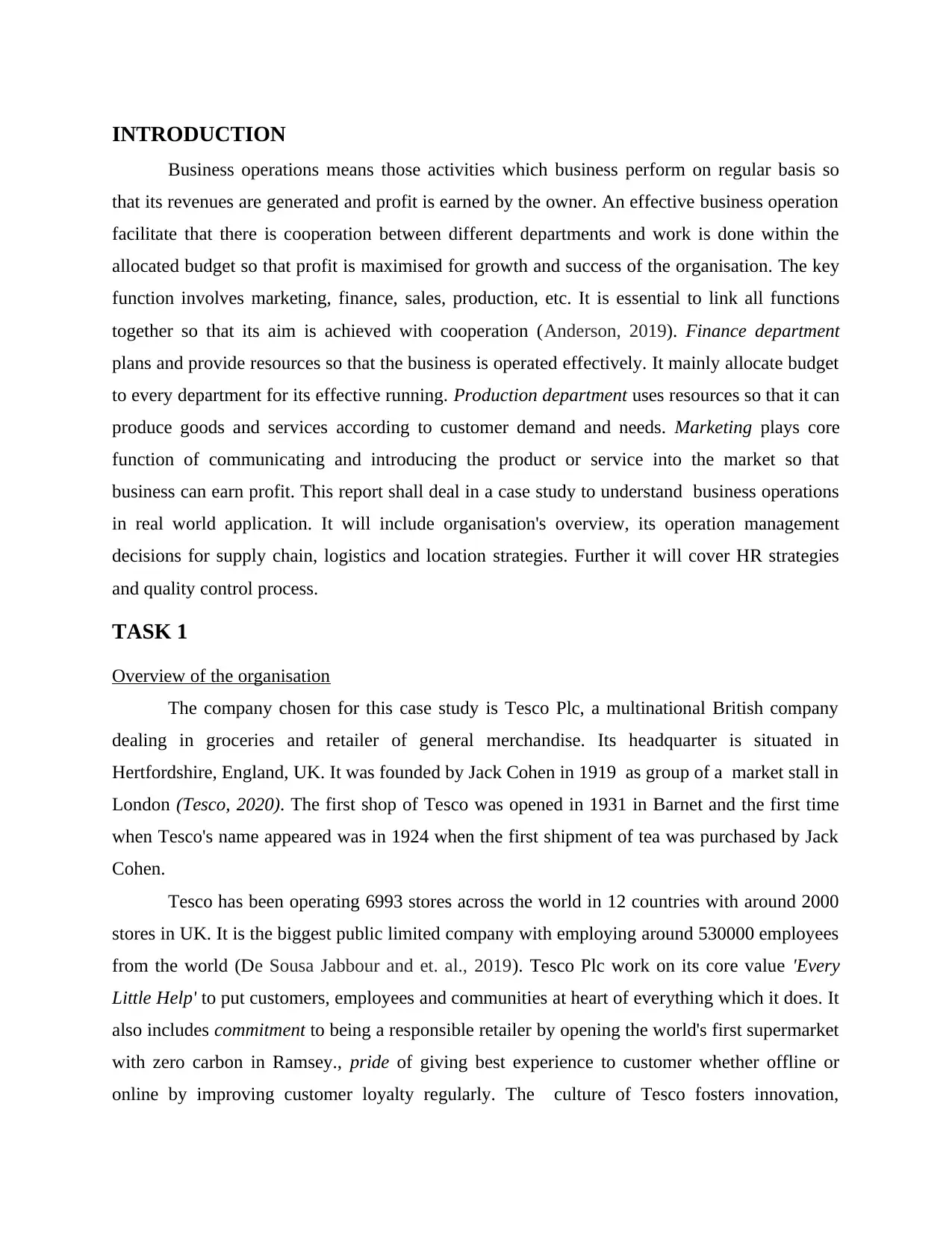
INTRODUCTION
Business operations means those activities which business perform on regular basis so
that its revenues are generated and profit is earned by the owner. An effective business operation
facilitate that there is cooperation between different departments and work is done within the
allocated budget so that profit is maximised for growth and success of the organisation. The key
function involves marketing, finance, sales, production, etc. It is essential to link all functions
together so that its aim is achieved with cooperation (Anderson, 2019). Finance department
plans and provide resources so that the business is operated effectively. It mainly allocate budget
to every department for its effective running. Production department uses resources so that it can
produce goods and services according to customer demand and needs. Marketing plays core
function of communicating and introducing the product or service into the market so that
business can earn profit. This report shall deal in a case study to understand business operations
in real world application. It will include organisation's overview, its operation management
decisions for supply chain, logistics and location strategies. Further it will cover HR strategies
and quality control process.
TASK 1
Overview of the organisation
The company chosen for this case study is Tesco Plc, a multinational British company
dealing in groceries and retailer of general merchandise. Its headquarter is situated in
Hertfordshire, England, UK. It was founded by Jack Cohen in 1919 as group of a market stall in
London (Tesco, 2020). The first shop of Tesco was opened in 1931 in Barnet and the first time
when Tesco's name appeared was in 1924 when the first shipment of tea was purchased by Jack
Cohen.
Tesco has been operating 6993 stores across the world in 12 countries with around 2000
stores in UK. It is the biggest public limited company with employing around 530000 employees
from the world (De Sousa Jabbour and et. al., 2019). Tesco Plc work on its core value 'Every
Little Help' to put customers, employees and communities at heart of everything which it does. It
also includes commitment to being a responsible retailer by opening the world's first supermarket
with zero carbon in Ramsey., pride of giving best experience to customer whether offline or
online by improving customer loyalty regularly. The culture of Tesco fosters innovation,
Business operations means those activities which business perform on regular basis so
that its revenues are generated and profit is earned by the owner. An effective business operation
facilitate that there is cooperation between different departments and work is done within the
allocated budget so that profit is maximised for growth and success of the organisation. The key
function involves marketing, finance, sales, production, etc. It is essential to link all functions
together so that its aim is achieved with cooperation (Anderson, 2019). Finance department
plans and provide resources so that the business is operated effectively. It mainly allocate budget
to every department for its effective running. Production department uses resources so that it can
produce goods and services according to customer demand and needs. Marketing plays core
function of communicating and introducing the product or service into the market so that
business can earn profit. This report shall deal in a case study to understand business operations
in real world application. It will include organisation's overview, its operation management
decisions for supply chain, logistics and location strategies. Further it will cover HR strategies
and quality control process.
TASK 1
Overview of the organisation
The company chosen for this case study is Tesco Plc, a multinational British company
dealing in groceries and retailer of general merchandise. Its headquarter is situated in
Hertfordshire, England, UK. It was founded by Jack Cohen in 1919 as group of a market stall in
London (Tesco, 2020). The first shop of Tesco was opened in 1931 in Barnet and the first time
when Tesco's name appeared was in 1924 when the first shipment of tea was purchased by Jack
Cohen.
Tesco has been operating 6993 stores across the world in 12 countries with around 2000
stores in UK. It is the biggest public limited company with employing around 530000 employees
from the world (De Sousa Jabbour and et. al., 2019). Tesco Plc work on its core value 'Every
Little Help' to put customers, employees and communities at heart of everything which it does. It
also includes commitment to being a responsible retailer by opening the world's first supermarket
with zero carbon in Ramsey., pride of giving best experience to customer whether offline or
online by improving customer loyalty regularly. The culture of Tesco fosters innovation,
⊘ This is a preview!⊘
Do you want full access?
Subscribe today to unlock all pages.

Trusted by 1+ million students worldwide
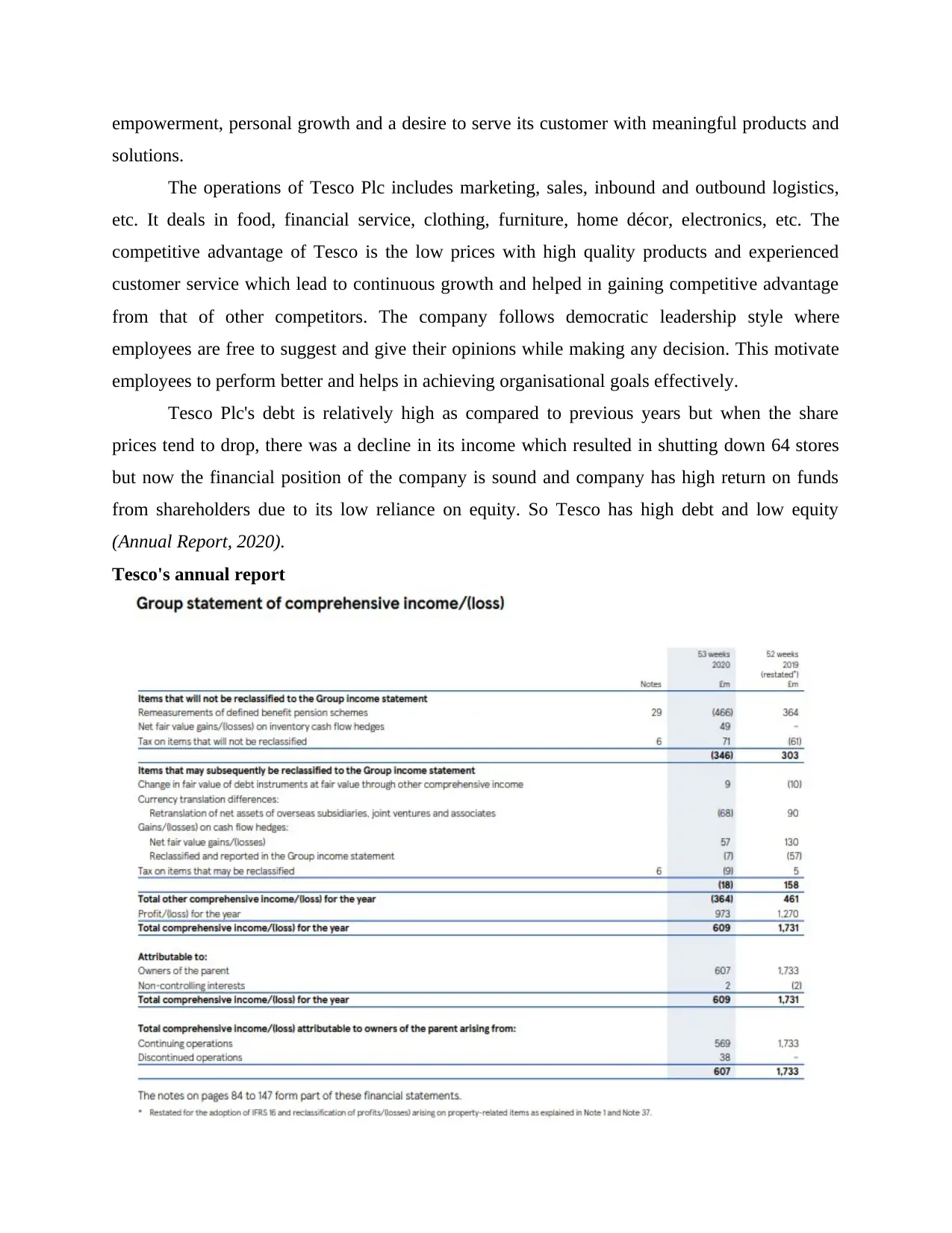
empowerment, personal growth and a desire to serve its customer with meaningful products and
solutions.
The operations of Tesco Plc includes marketing, sales, inbound and outbound logistics,
etc. It deals in food, financial service, clothing, furniture, home décor, electronics, etc. The
competitive advantage of Tesco is the low prices with high quality products and experienced
customer service which lead to continuous growth and helped in gaining competitive advantage
from that of other competitors. The company follows democratic leadership style where
employees are free to suggest and give their opinions while making any decision. This motivate
employees to perform better and helps in achieving organisational goals effectively.
Tesco Plc's debt is relatively high as compared to previous years but when the share
prices tend to drop, there was a decline in its income which resulted in shutting down 64 stores
but now the financial position of the company is sound and company has high return on funds
from shareholders due to its low reliance on equity. So Tesco has high debt and low equity
(Annual Report, 2020).
Tesco's annual report
solutions.
The operations of Tesco Plc includes marketing, sales, inbound and outbound logistics,
etc. It deals in food, financial service, clothing, furniture, home décor, electronics, etc. The
competitive advantage of Tesco is the low prices with high quality products and experienced
customer service which lead to continuous growth and helped in gaining competitive advantage
from that of other competitors. The company follows democratic leadership style where
employees are free to suggest and give their opinions while making any decision. This motivate
employees to perform better and helps in achieving organisational goals effectively.
Tesco Plc's debt is relatively high as compared to previous years but when the share
prices tend to drop, there was a decline in its income which resulted in shutting down 64 stores
but now the financial position of the company is sound and company has high return on funds
from shareholders due to its low reliance on equity. So Tesco has high debt and low equity
(Annual Report, 2020).
Tesco's annual report
Paraphrase This Document
Need a fresh take? Get an instant paraphrase of this document with our AI Paraphraser
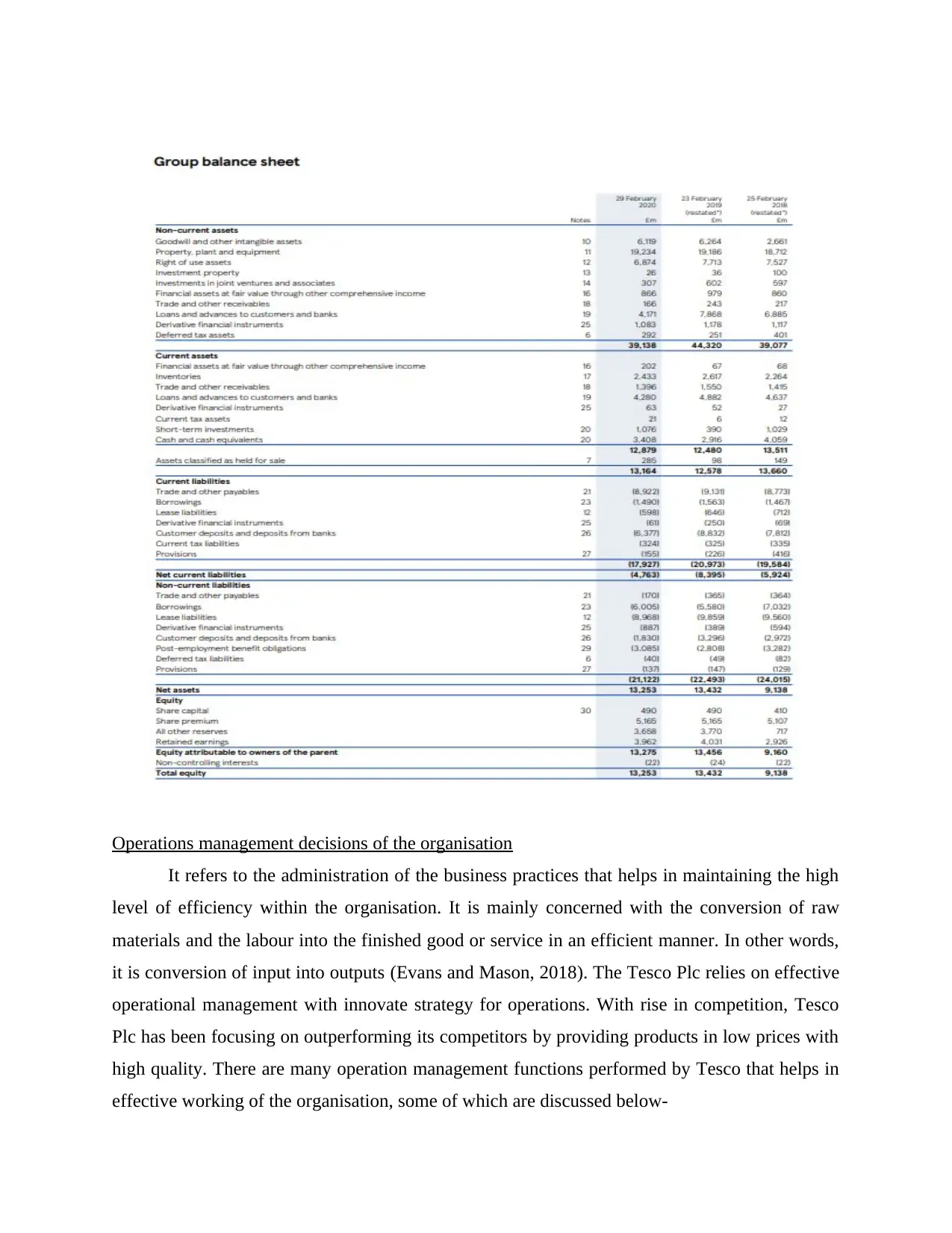
Operations management decisions of the organisation
It refers to the administration of the business practices that helps in maintaining the high
level of efficiency within the organisation. It is mainly concerned with the conversion of raw
materials and the labour into the finished good or service in an efficient manner. In other words,
it is conversion of input into outputs (Evans and Mason, 2018). The Tesco Plc relies on effective
operational management with innovate strategy for operations. With rise in competition, Tesco
Plc has been focusing on outperforming its competitors by providing products in low prices with
high quality. There are many operation management functions performed by Tesco that helps in
effective working of the organisation, some of which are discussed below-
It refers to the administration of the business practices that helps in maintaining the high
level of efficiency within the organisation. It is mainly concerned with the conversion of raw
materials and the labour into the finished good or service in an efficient manner. In other words,
it is conversion of input into outputs (Evans and Mason, 2018). The Tesco Plc relies on effective
operational management with innovate strategy for operations. With rise in competition, Tesco
Plc has been focusing on outperforming its competitors by providing products in low prices with
high quality. There are many operation management functions performed by Tesco that helps in
effective working of the organisation, some of which are discussed below-
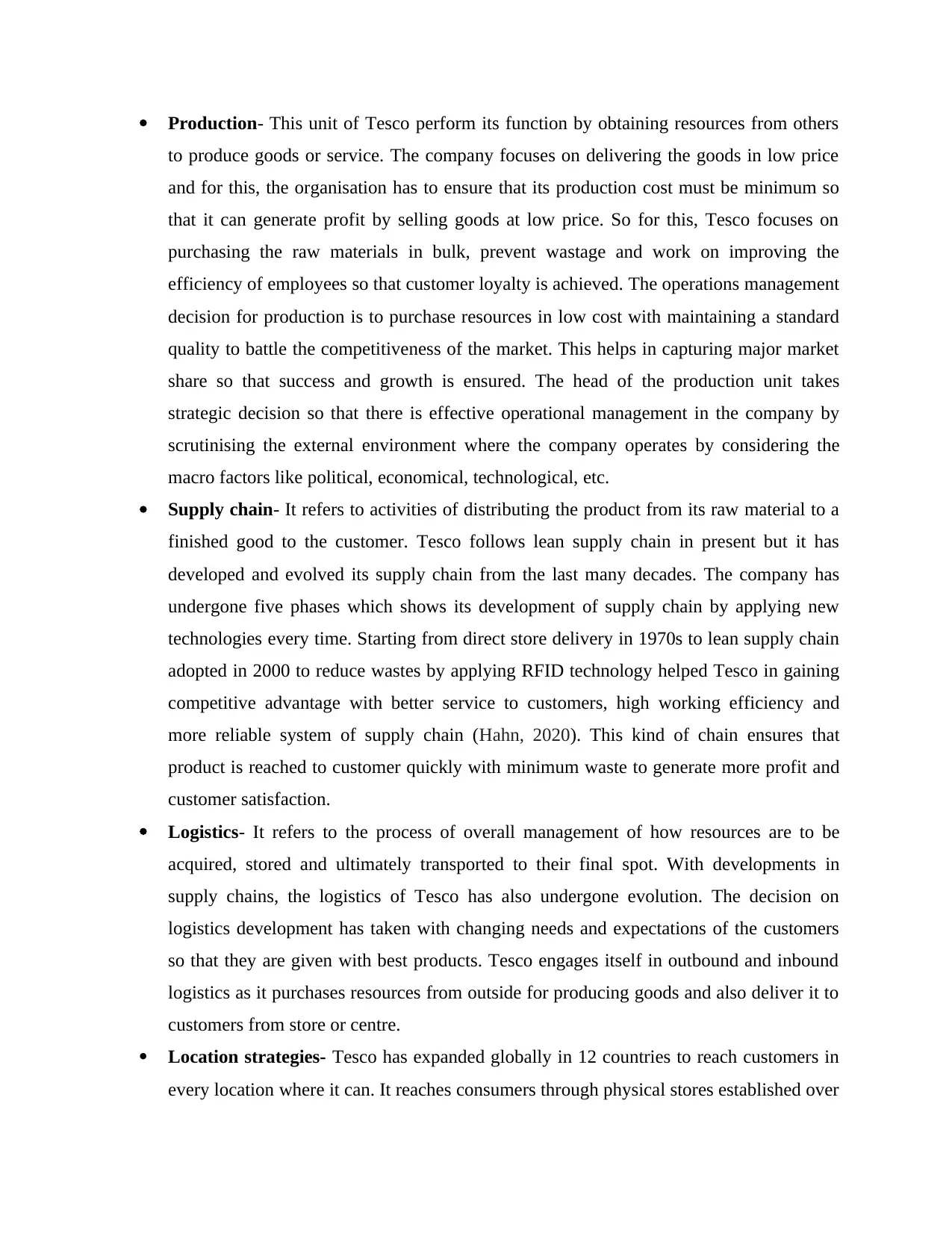
Production- This unit of Tesco perform its function by obtaining resources from others
to produce goods or service. The company focuses on delivering the goods in low price
and for this, the organisation has to ensure that its production cost must be minimum so
that it can generate profit by selling goods at low price. So for this, Tesco focuses on
purchasing the raw materials in bulk, prevent wastage and work on improving the
efficiency of employees so that customer loyalty is achieved. The operations management
decision for production is to purchase resources in low cost with maintaining a standard
quality to battle the competitiveness of the market. This helps in capturing major market
share so that success and growth is ensured. The head of the production unit takes
strategic decision so that there is effective operational management in the company by
scrutinising the external environment where the company operates by considering the
macro factors like political, economical, technological, etc.
Supply chain- It refers to activities of distributing the product from its raw material to a
finished good to the customer. Tesco follows lean supply chain in present but it has
developed and evolved its supply chain from the last many decades. The company has
undergone five phases which shows its development of supply chain by applying new
technologies every time. Starting from direct store delivery in 1970s to lean supply chain
adopted in 2000 to reduce wastes by applying RFID technology helped Tesco in gaining
competitive advantage with better service to customers, high working efficiency and
more reliable system of supply chain (Hahn, 2020). This kind of chain ensures that
product is reached to customer quickly with minimum waste to generate more profit and
customer satisfaction.
Logistics- It refers to the process of overall management of how resources are to be
acquired, stored and ultimately transported to their final spot. With developments in
supply chains, the logistics of Tesco has also undergone evolution. The decision on
logistics development has taken with changing needs and expectations of the customers
so that they are given with best products. Tesco engages itself in outbound and inbound
logistics as it purchases resources from outside for producing goods and also deliver it to
customers from store or centre.
Location strategies- Tesco has expanded globally in 12 countries to reach customers in
every location where it can. It reaches consumers through physical stores established over
to produce goods or service. The company focuses on delivering the goods in low price
and for this, the organisation has to ensure that its production cost must be minimum so
that it can generate profit by selling goods at low price. So for this, Tesco focuses on
purchasing the raw materials in bulk, prevent wastage and work on improving the
efficiency of employees so that customer loyalty is achieved. The operations management
decision for production is to purchase resources in low cost with maintaining a standard
quality to battle the competitiveness of the market. This helps in capturing major market
share so that success and growth is ensured. The head of the production unit takes
strategic decision so that there is effective operational management in the company by
scrutinising the external environment where the company operates by considering the
macro factors like political, economical, technological, etc.
Supply chain- It refers to activities of distributing the product from its raw material to a
finished good to the customer. Tesco follows lean supply chain in present but it has
developed and evolved its supply chain from the last many decades. The company has
undergone five phases which shows its development of supply chain by applying new
technologies every time. Starting from direct store delivery in 1970s to lean supply chain
adopted in 2000 to reduce wastes by applying RFID technology helped Tesco in gaining
competitive advantage with better service to customers, high working efficiency and
more reliable system of supply chain (Hahn, 2020). This kind of chain ensures that
product is reached to customer quickly with minimum waste to generate more profit and
customer satisfaction.
Logistics- It refers to the process of overall management of how resources are to be
acquired, stored and ultimately transported to their final spot. With developments in
supply chains, the logistics of Tesco has also undergone evolution. The decision on
logistics development has taken with changing needs and expectations of the customers
so that they are given with best products. Tesco engages itself in outbound and inbound
logistics as it purchases resources from outside for producing goods and also deliver it to
customers from store or centre.
Location strategies- Tesco has expanded globally in 12 countries to reach customers in
every location where it can. It reaches consumers through physical stores established over
⊘ This is a preview!⊘
Do you want full access?
Subscribe today to unlock all pages.

Trusted by 1+ million students worldwide
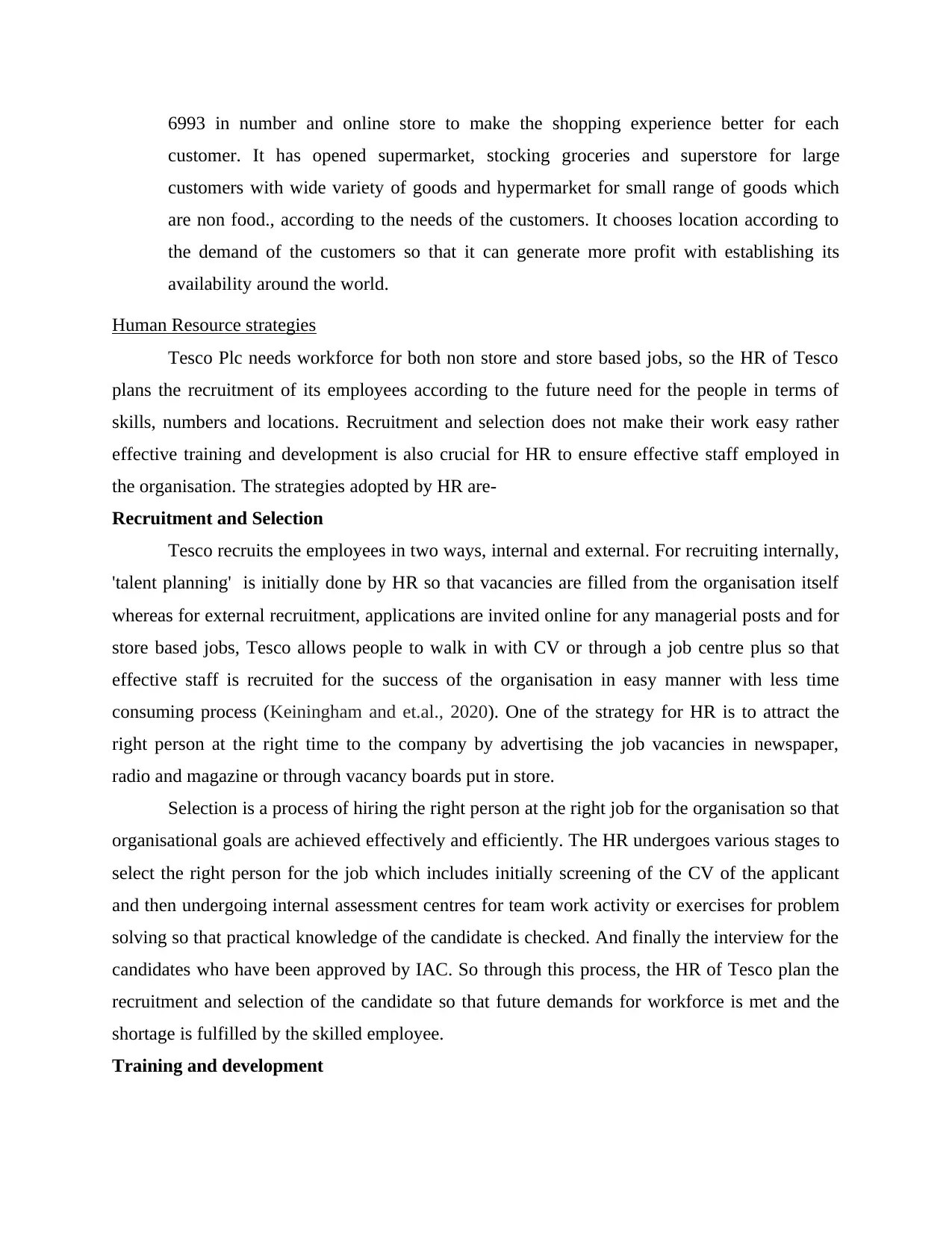
6993 in number and online store to make the shopping experience better for each
customer. It has opened supermarket, stocking groceries and superstore for large
customers with wide variety of goods and hypermarket for small range of goods which
are non food., according to the needs of the customers. It chooses location according to
the demand of the customers so that it can generate more profit with establishing its
availability around the world.
Human Resource strategies
Tesco Plc needs workforce for both non store and store based jobs, so the HR of Tesco
plans the recruitment of its employees according to the future need for the people in terms of
skills, numbers and locations. Recruitment and selection does not make their work easy rather
effective training and development is also crucial for HR to ensure effective staff employed in
the organisation. The strategies adopted by HR are-
Recruitment and Selection
Tesco recruits the employees in two ways, internal and external. For recruiting internally,
'talent planning' is initially done by HR so that vacancies are filled from the organisation itself
whereas for external recruitment, applications are invited online for any managerial posts and for
store based jobs, Tesco allows people to walk in with CV or through a job centre plus so that
effective staff is recruited for the success of the organisation in easy manner with less time
consuming process (Keiningham and et.al., 2020). One of the strategy for HR is to attract the
right person at the right time to the company by advertising the job vacancies in newspaper,
radio and magazine or through vacancy boards put in store.
Selection is a process of hiring the right person at the right job for the organisation so that
organisational goals are achieved effectively and efficiently. The HR undergoes various stages to
select the right person for the job which includes initially screening of the CV of the applicant
and then undergoing internal assessment centres for team work activity or exercises for problem
solving so that practical knowledge of the candidate is checked. And finally the interview for the
candidates who have been approved by IAC. So through this process, the HR of Tesco plan the
recruitment and selection of the candidate so that future demands for workforce is met and the
shortage is fulfilled by the skilled employee.
Training and development
customer. It has opened supermarket, stocking groceries and superstore for large
customers with wide variety of goods and hypermarket for small range of goods which
are non food., according to the needs of the customers. It chooses location according to
the demand of the customers so that it can generate more profit with establishing its
availability around the world.
Human Resource strategies
Tesco Plc needs workforce for both non store and store based jobs, so the HR of Tesco
plans the recruitment of its employees according to the future need for the people in terms of
skills, numbers and locations. Recruitment and selection does not make their work easy rather
effective training and development is also crucial for HR to ensure effective staff employed in
the organisation. The strategies adopted by HR are-
Recruitment and Selection
Tesco recruits the employees in two ways, internal and external. For recruiting internally,
'talent planning' is initially done by HR so that vacancies are filled from the organisation itself
whereas for external recruitment, applications are invited online for any managerial posts and for
store based jobs, Tesco allows people to walk in with CV or through a job centre plus so that
effective staff is recruited for the success of the organisation in easy manner with less time
consuming process (Keiningham and et.al., 2020). One of the strategy for HR is to attract the
right person at the right time to the company by advertising the job vacancies in newspaper,
radio and magazine or through vacancy boards put in store.
Selection is a process of hiring the right person at the right job for the organisation so that
organisational goals are achieved effectively and efficiently. The HR undergoes various stages to
select the right person for the job which includes initially screening of the CV of the applicant
and then undergoing internal assessment centres for team work activity or exercises for problem
solving so that practical knowledge of the candidate is checked. And finally the interview for the
candidates who have been approved by IAC. So through this process, the HR of Tesco plan the
recruitment and selection of the candidate so that future demands for workforce is met and the
shortage is fulfilled by the skilled employee.
Training and development
Paraphrase This Document
Need a fresh take? Get an instant paraphrase of this document with our AI Paraphraser
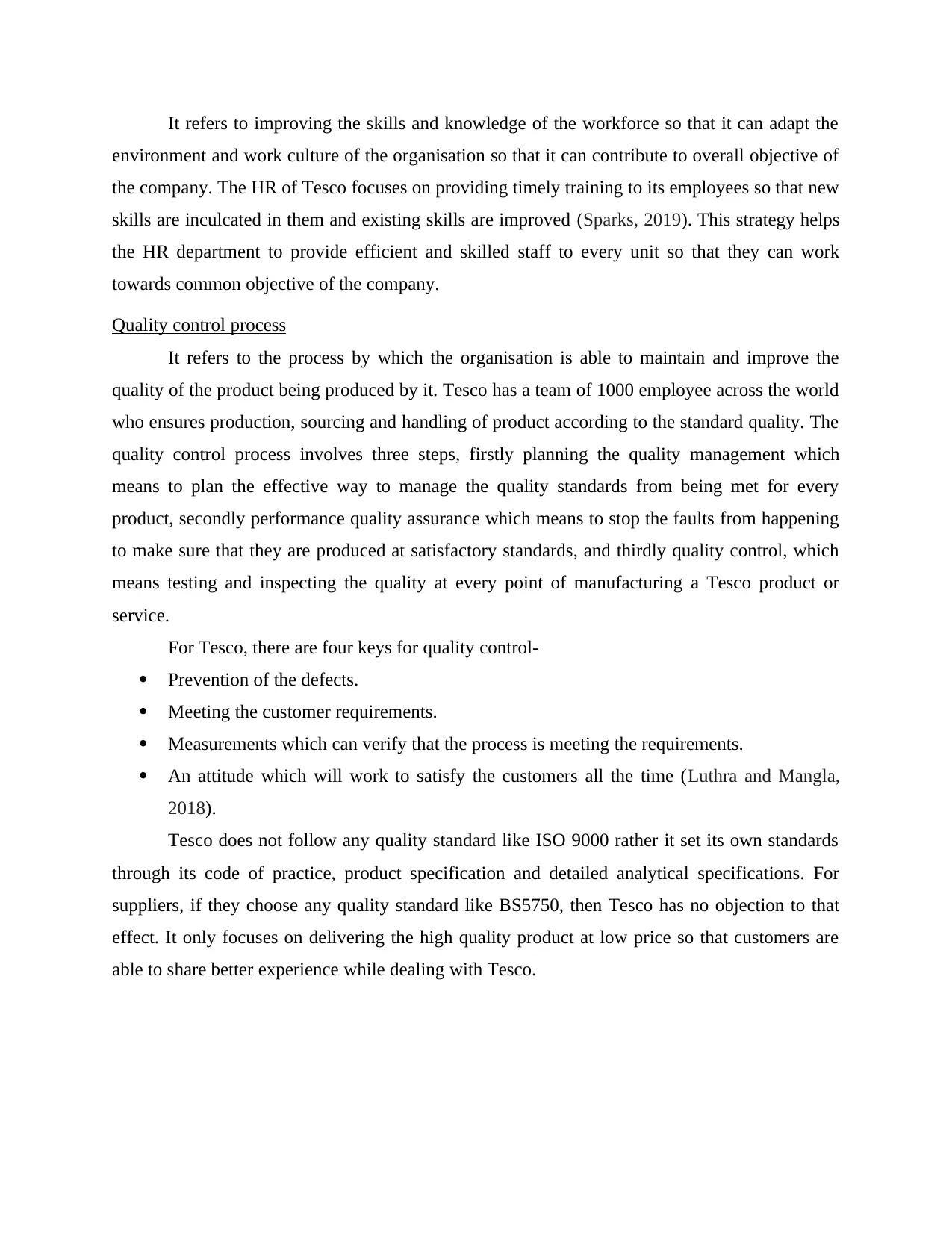
It refers to improving the skills and knowledge of the workforce so that it can adapt the
environment and work culture of the organisation so that it can contribute to overall objective of
the company. The HR of Tesco focuses on providing timely training to its employees so that new
skills are inculcated in them and existing skills are improved (Sparks, 2019). This strategy helps
the HR department to provide efficient and skilled staff to every unit so that they can work
towards common objective of the company.
Quality control process
It refers to the process by which the organisation is able to maintain and improve the
quality of the product being produced by it. Tesco has a team of 1000 employee across the world
who ensures production, sourcing and handling of product according to the standard quality. The
quality control process involves three steps, firstly planning the quality management which
means to plan the effective way to manage the quality standards from being met for every
product, secondly performance quality assurance which means to stop the faults from happening
to make sure that they are produced at satisfactory standards, and thirdly quality control, which
means testing and inspecting the quality at every point of manufacturing a Tesco product or
service.
For Tesco, there are four keys for quality control-
Prevention of the defects.
Meeting the customer requirements.
Measurements which can verify that the process is meeting the requirements.
An attitude which will work to satisfy the customers all the time (Luthra and Mangla,
2018).
Tesco does not follow any quality standard like ISO 9000 rather it set its own standards
through its code of practice, product specification and detailed analytical specifications. For
suppliers, if they choose any quality standard like BS5750, then Tesco has no objection to that
effect. It only focuses on delivering the high quality product at low price so that customers are
able to share better experience while dealing with Tesco.
environment and work culture of the organisation so that it can contribute to overall objective of
the company. The HR of Tesco focuses on providing timely training to its employees so that new
skills are inculcated in them and existing skills are improved (Sparks, 2019). This strategy helps
the HR department to provide efficient and skilled staff to every unit so that they can work
towards common objective of the company.
Quality control process
It refers to the process by which the organisation is able to maintain and improve the
quality of the product being produced by it. Tesco has a team of 1000 employee across the world
who ensures production, sourcing and handling of product according to the standard quality. The
quality control process involves three steps, firstly planning the quality management which
means to plan the effective way to manage the quality standards from being met for every
product, secondly performance quality assurance which means to stop the faults from happening
to make sure that they are produced at satisfactory standards, and thirdly quality control, which
means testing and inspecting the quality at every point of manufacturing a Tesco product or
service.
For Tesco, there are four keys for quality control-
Prevention of the defects.
Meeting the customer requirements.
Measurements which can verify that the process is meeting the requirements.
An attitude which will work to satisfy the customers all the time (Luthra and Mangla,
2018).
Tesco does not follow any quality standard like ISO 9000 rather it set its own standards
through its code of practice, product specification and detailed analytical specifications. For
suppliers, if they choose any quality standard like BS5750, then Tesco has no objection to that
effect. It only focuses on delivering the high quality product at low price so that customers are
able to share better experience while dealing with Tesco.
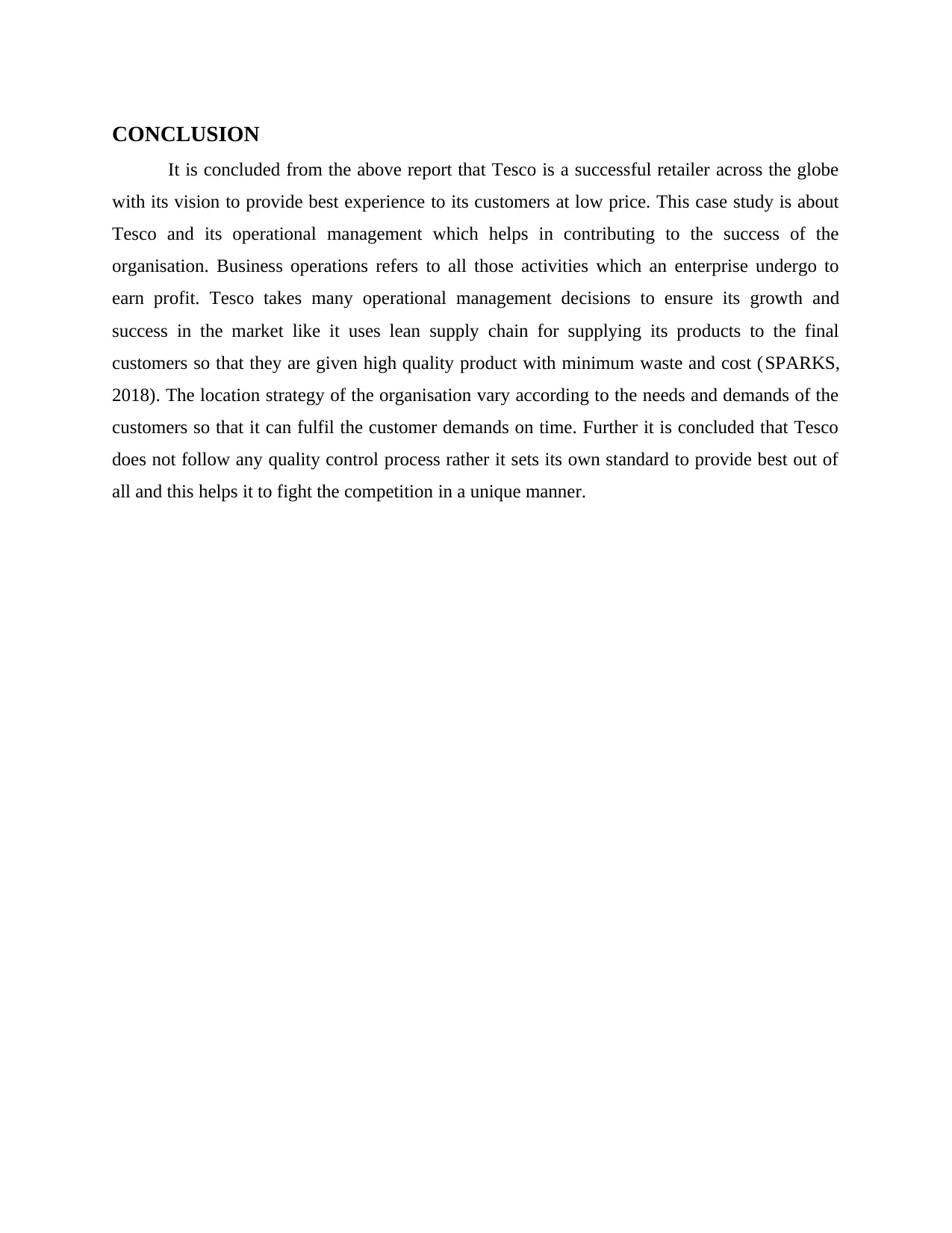
CONCLUSION
It is concluded from the above report that Tesco is a successful retailer across the globe
with its vision to provide best experience to its customers at low price. This case study is about
Tesco and its operational management which helps in contributing to the success of the
organisation. Business operations refers to all those activities which an enterprise undergo to
earn profit. Tesco takes many operational management decisions to ensure its growth and
success in the market like it uses lean supply chain for supplying its products to the final
customers so that they are given high quality product with minimum waste and cost (SPARKS,
2018). The location strategy of the organisation vary according to the needs and demands of the
customers so that it can fulfil the customer demands on time. Further it is concluded that Tesco
does not follow any quality control process rather it sets its own standard to provide best out of
all and this helps it to fight the competition in a unique manner.
It is concluded from the above report that Tesco is a successful retailer across the globe
with its vision to provide best experience to its customers at low price. This case study is about
Tesco and its operational management which helps in contributing to the success of the
organisation. Business operations refers to all those activities which an enterprise undergo to
earn profit. Tesco takes many operational management decisions to ensure its growth and
success in the market like it uses lean supply chain for supplying its products to the final
customers so that they are given high quality product with minimum waste and cost (SPARKS,
2018). The location strategy of the organisation vary according to the needs and demands of the
customers so that it can fulfil the customer demands on time. Further it is concluded that Tesco
does not follow any quality control process rather it sets its own standard to provide best out of
all and this helps it to fight the competition in a unique manner.
⊘ This is a preview!⊘
Do you want full access?
Subscribe today to unlock all pages.

Trusted by 1+ million students worldwide
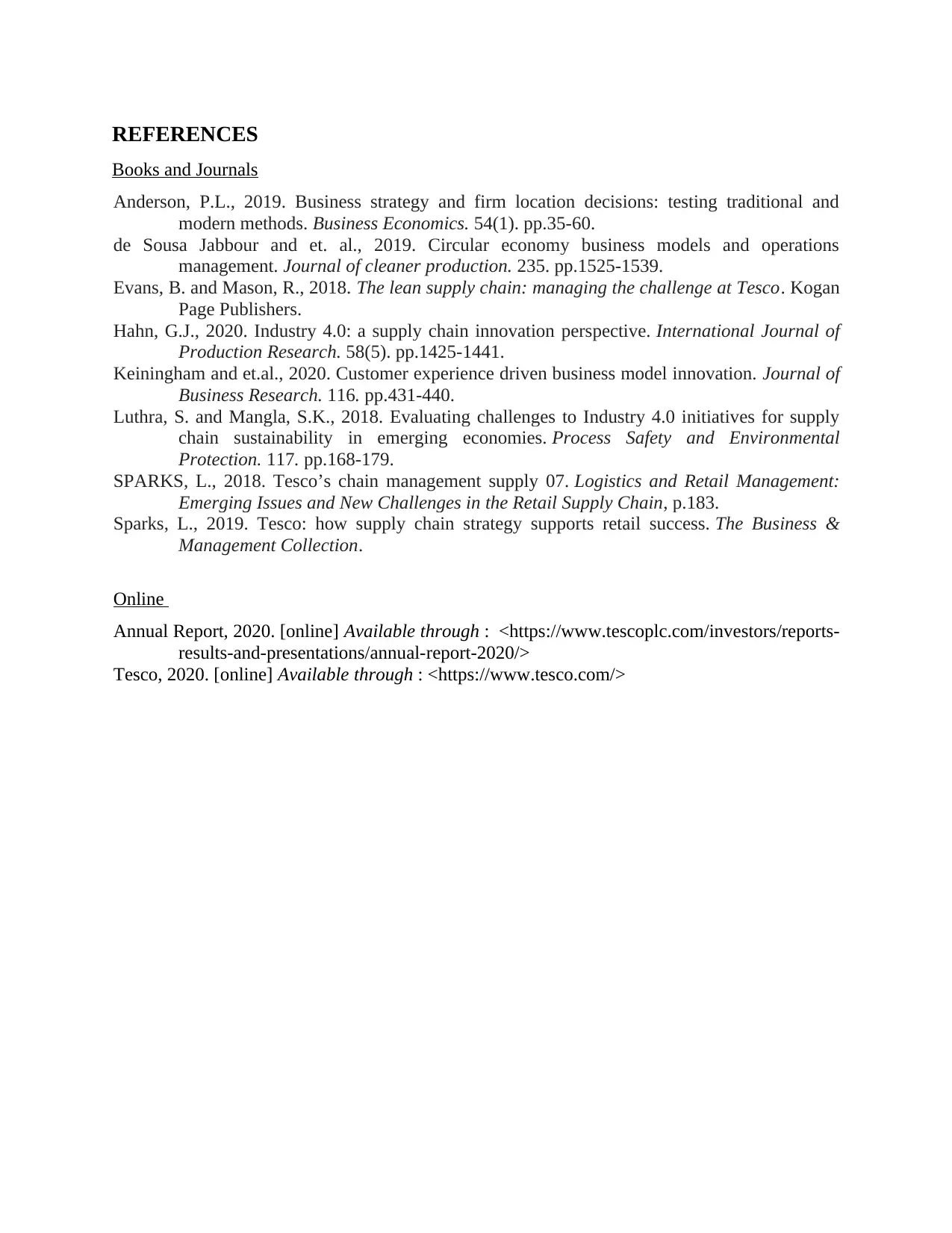
REFERENCES
Books and Journals
Anderson, P.L., 2019. Business strategy and firm location decisions: testing traditional and
modern methods. Business Economics. 54(1). pp.35-60.
de Sousa Jabbour and et. al., 2019. Circular economy business models and operations
management. Journal of cleaner production. 235. pp.1525-1539.
Evans, B. and Mason, R., 2018. The lean supply chain: managing the challenge at Tesco. Kogan
Page Publishers.
Hahn, G.J., 2020. Industry 4.0: a supply chain innovation perspective. International Journal of
Production Research. 58(5). pp.1425-1441.
Keiningham and et.al., 2020. Customer experience driven business model innovation. Journal of
Business Research. 116. pp.431-440.
Luthra, S. and Mangla, S.K., 2018. Evaluating challenges to Industry 4.0 initiatives for supply
chain sustainability in emerging economies. Process Safety and Environmental
Protection. 117. pp.168-179.
SPARKS, L., 2018. Tesco’s chain management supply 07. Logistics and Retail Management:
Emerging Issues and New Challenges in the Retail Supply Chain, p.183.
Sparks, L., 2019. Tesco: how supply chain strategy supports retail success. The Business &
Management Collection.
Online
Annual Report, 2020. [online] Available through : <https://www.tescoplc.com/investors/reports-
results-and-presentations/annual-report-2020/>
Tesco, 2020. [online] Available through : <https://www.tesco.com/>
Books and Journals
Anderson, P.L., 2019. Business strategy and firm location decisions: testing traditional and
modern methods. Business Economics. 54(1). pp.35-60.
de Sousa Jabbour and et. al., 2019. Circular economy business models and operations
management. Journal of cleaner production. 235. pp.1525-1539.
Evans, B. and Mason, R., 2018. The lean supply chain: managing the challenge at Tesco. Kogan
Page Publishers.
Hahn, G.J., 2020. Industry 4.0: a supply chain innovation perspective. International Journal of
Production Research. 58(5). pp.1425-1441.
Keiningham and et.al., 2020. Customer experience driven business model innovation. Journal of
Business Research. 116. pp.431-440.
Luthra, S. and Mangla, S.K., 2018. Evaluating challenges to Industry 4.0 initiatives for supply
chain sustainability in emerging economies. Process Safety and Environmental
Protection. 117. pp.168-179.
SPARKS, L., 2018. Tesco’s chain management supply 07. Logistics and Retail Management:
Emerging Issues and New Challenges in the Retail Supply Chain, p.183.
Sparks, L., 2019. Tesco: how supply chain strategy supports retail success. The Business &
Management Collection.
Online
Annual Report, 2020. [online] Available through : <https://www.tescoplc.com/investors/reports-
results-and-presentations/annual-report-2020/>
Tesco, 2020. [online] Available through : <https://www.tesco.com/>
1 out of 10
Related Documents
Your All-in-One AI-Powered Toolkit for Academic Success.
+13062052269
info@desklib.com
Available 24*7 on WhatsApp / Email
![[object Object]](/_next/static/media/star-bottom.7253800d.svg)
Unlock your academic potential
Copyright © 2020–2025 A2Z Services. All Rights Reserved. Developed and managed by ZUCOL.




